The two most common forms of A193 bolts manufactured, stocked, sold, and purchased in the marketplace are either fully threaded studs or heavy hex bolts. “B7 studs” are the most common product used within this specification. Engineers will specify other configurations of fasteners under the A193 specification, but they are far less frequent. The following labor operations are involved in producing fully threaded rods, heavy hex bolts, and other forms of fasteners including bent bolts.
Fully Threaded Studs
Fully threaded studs, or simply “studs” as they are most frequently called, are a continuously threaded straight piece of steel. Studs have a variety of alternate names and acronyms including TFL studs (thread full length), ATR (all thread rod), TS (threaded studs), threaded rods, and redi-rod. Studs are nutted on both ends and used in a variety of applications.
The vast majority of studs sold in the marketplace are cut and chamfered from longer lengths of mass-produced all thread rods. Under this scenario, 12’ lengths of B7, B8, B8m, or other grades of A193 threaded rod are manufactured by taking pitch diameter round bar and passing it through cylindrical threading dies which displace the steel and “rolls” the threads onto the rod. Grade B7 is threaded in a heat-treated condition. These 12’ lengths of all thread rod are stocked by fastener manufacturers and distributors who cut the studs to length, chamfer them, and stamp them with the grade symbol and manufacturer’s identifier when an order is placed.
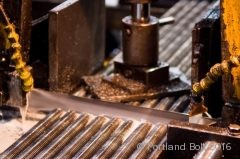 Cutting: Long lengths (typically 12’) of all thread rod are cut to size using a band saw.
Cutting: Long lengths (typically 12’) of all thread rod are cut to size using a band saw.- Chamfering: After the studs have been cut to length, they are chamfered, which bevels the end. This machining process removes the first thread, facilitating easy nut assembly and reducing the risk of thread damage at the ends of the studs.
- Stamping: The A193 specification requires the grade symbol and manufacturer’s unique identifier to be marked on one end of each stud. This is often performed by the same equipment used to chamfer the ends of the studs.
Fully threaded studs, when ordered in large quantities, are sometimes processed differently than in the scenario described above. Round bar is first cut to length and then run through a cylindrical roll threader. When processed in this order, chamfering may not be necessary due to the burnishing effect on the end of the threads. Stamping of the grade symbol and manufacturer’s mark is applied after threading. Companies that produce short, threaded studs in this manner are the same companies that service the fastener industry with 12’ lengths of all thread. The number of companies possessing thread rollers capable of producing all thread rod in this fashion is limited.
Heavy Hex Bolts
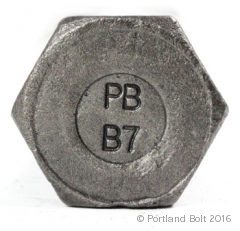 Heavy hex bolts have a hexagonal head forged on one end, are threaded on the other end, and fastened with a single heavy hex nut. There are many applications in which heavy hex bolts and studs can be used interchangeably, but any substitution of one for the other should be approved by the Engineer of Record. Unlike nuts on the ends of studs, forged heads cannot loosen and may be a better option when the potential for nuts backing off is high. Heavy hex bolts are cut to length, headed, threaded, chamfered, heat treated or solution annealed, and mechanically tested. A cold heading process is used to mass-produce common sized heavy hex bolts, while a hot forging process is used for nonstandard sizes that are typically larger in diameter or longer in length than sizes that are readily available in the marketplace.
Heavy hex bolts have a hexagonal head forged on one end, are threaded on the other end, and fastened with a single heavy hex nut. There are many applications in which heavy hex bolts and studs can be used interchangeably, but any substitution of one for the other should be approved by the Engineer of Record. Unlike nuts on the ends of studs, forged heads cannot loosen and may be a better option when the potential for nuts backing off is high. Heavy hex bolts are cut to length, headed, threaded, chamfered, heat treated or solution annealed, and mechanically tested. A cold heading process is used to mass-produce common sized heavy hex bolts, while a hot forging process is used for nonstandard sizes that are typically larger in diameter or longer in length than sizes that are readily available in the marketplace.
Hot Forging
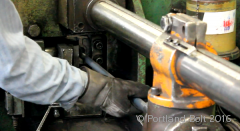 Cutting: Steel round bar ranging in length from 20’ – 40’ is either sheared or saw cut to length. Since headed bolts are measured from the underside of the head to the end of the threads, extra steel that will be compressed (forged) to form the head is added to the cut length.
Cutting: Steel round bar ranging in length from 20’ – 40’ is either sheared or saw cut to length. Since headed bolts are measured from the underside of the head to the end of the threads, extra steel that will be compressed (forged) to form the head is added to the cut length.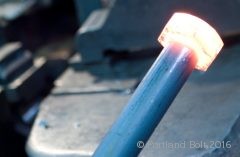 Heading: Heavy hex heads are formed by heating one end of the round bar and forging (reshaping) it with an upsetter or hydraulic press. The grade symbol and manufacturer’s identifier are added to the top of the head during this operation.
Heading: Heavy hex heads are formed by heating one end of the round bar and forging (reshaping) it with an upsetter or hydraulic press. The grade symbol and manufacturer’s identifier are added to the top of the head during this operation.- Threading: Threads can be either cut or rolled. Cut threading is a process in which steel is physically cut away from the round bar to form the threads. Roll threading is a process in which steel is displaced by forcing it between threading dies.
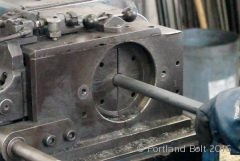 Chamfering: Chamfering is a process in which the first thread is removed to facilitate nut assembly.
Chamfering: Chamfering is a process in which the first thread is removed to facilitate nut assembly.- Quenching and Tempering: This is a two-step heat treating process in which bolts are heated to very high temperatures, rapidly cooled, and heated again at lower temperatures to provide ductility and bring the mechanical properties in line with the given ASTM specification. Grades B7, B16, B5, and B6 are quenched and tempered.
- Solution Annealing: A heat treating process performed on 300 series stainless in which nonferrous materials are heated to a specified temperature, held for a specified time, and cooled rapidly to ambient temperature. This process improves machinability and corrosion resistance.
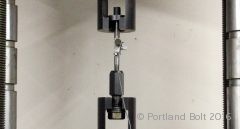 Mechanical Testing: Quenching and tempering and solution annealing both can affect the mechanical properties of a headed bolt. For this reason, A193 heavy hex bolts are tested to ensure minimum strength requirements are met. Most A193 specifications have requirements for tensile strength, yield strength, reduction of area, elongation, and hardness.
Mechanical Testing: Quenching and tempering and solution annealing both can affect the mechanical properties of a headed bolt. For this reason, A193 heavy hex bolts are tested to ensure minimum strength requirements are met. Most A193 specifications have requirements for tensile strength, yield strength, reduction of area, elongation, and hardness.
Cold Heading
Cold headed bolts are produced in a similar fashion to hot forged bolts, but the heads are formed at room temperature rather than being heated. Cold headed bolts are mass-produced by machinery and not handled through each labor operation as is the case with hot forged bolts. Huge coils of steel wire are fed into a straightener before being sheared to length. Next, they are fed through a series of dies that gradually form the heavy hex head. The area of the headed blanks to be threaded is extruded down to a pitch diameter before being roll threaded. The bolts are then solution annealed or quenched and tempered before being mechanically tested.
Bent Bolts
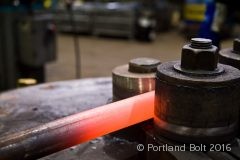 The A193 specification is not limited to heavy hex bolts and studs, although other configurations are specified far less frequently. Bent bolts of various styles are occasionally manufactured to meet the requirements of the A193 specification, especially in the stainless grades B8 and B8M. Bent products include round and square U-bolts, right angle anchor bolts, round and square hook bolts, and eye bolts.
The A193 specification is not limited to heavy hex bolts and studs, although other configurations are specified far less frequently. Bent bolts of various styles are occasionally manufactured to meet the requirements of the A193 specification, especially in the stainless grades B8 and B8M. Bent products include round and square U-bolts, right angle anchor bolts, round and square hook bolts, and eye bolts.
During the manufacturing of these products, the round bar is cut, threaded and then bent into the proper configuration. The bolts can be heated and bent or bent at room temperature. When heated to facilitate bending and depending on the grade, the bolts will undergo a heat treating or solution annealing process after bending.
Hot-dip Galvanizing
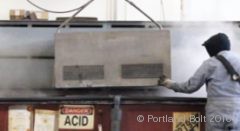 Grades of A193 bolts that are not made from stainless steel, are occasionally treated with a corrosion-resistant coating. The most common process is hot-dip galvanizing, in which zinc is metallurgically bonded to the steel. Before being galvanized, the bolts are cleaned. Bolts with excessive mill or heat treating scale are wheelabrated. Bolts without excessive scale will skip this preparation process. Bolts are then submerged in caustic soda to remove cutting oil and grime picked up during the manufacturing process. The bolts are then rinsed and dipped in sulfuric acid to remove any remaining scale and etch the surface of the bolts, allowing the zinc to adhere. Finally the bolts are rinsed and submered in flux, a chemical that assists in the bonding of the zinc to the steel.
Grades of A193 bolts that are not made from stainless steel, are occasionally treated with a corrosion-resistant coating. The most common process is hot-dip galvanizing, in which zinc is metallurgically bonded to the steel. Before being galvanized, the bolts are cleaned. Bolts with excessive mill or heat treating scale are wheelabrated. Bolts without excessive scale will skip this preparation process. Bolts are then submerged in caustic soda to remove cutting oil and grime picked up during the manufacturing process. The bolts are then rinsed and dipped in sulfuric acid to remove any remaining scale and etch the surface of the bolts, allowing the zinc to adhere. Finally the bolts are rinsed and submered in flux, a chemical that assists in the bonding of the zinc to the steel.
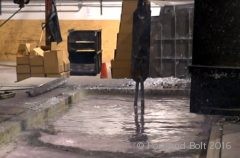 Now that the bolts are thoroughly cleaned, they ready to be “dipped” in an 840 degree tank of molten zinc. Once the bolts have been submerged long enough (a few minutes) to build up the proper coating thickness, they are removed from the galvanizing tank and spun in a high speed centrifuge to remove the excess zinc from the bolts and threads. ASTM specification F2329 covers the hot-dip galvanizing of threaded fasteners. Other corrosion-resistant coatings include Xylan, Teflon, PTFE, zinc aluminum, mechanical galvanizing, zinc plating, and cadmium plating.
Now that the bolts are thoroughly cleaned, they ready to be “dipped” in an 840 degree tank of molten zinc. Once the bolts have been submerged long enough (a few minutes) to build up the proper coating thickness, they are removed from the galvanizing tank and spun in a high speed centrifuge to remove the excess zinc from the bolts and threads. ASTM specification F2329 covers the hot-dip galvanizing of threaded fasteners. Other corrosion-resistant coatings include Xylan, Teflon, PTFE, zinc aluminum, mechanical galvanizing, zinc plating, and cadmium plating.
